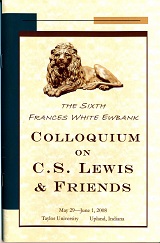Event Title
Session 4-A: George MacDonald and His Meanings
Location
Taylor University, Metcalf 101
Start Date
31-5-2008 10:00 AM
Description
"Goblinisation: The Marginalization of the Colonial Subject in The Princess and the Goblin and The Princess and Curdie" - Rachel Johnson
George MacDonald’s two longer fairy tales, Princess and the Goblin (1872) and The Princess and Curdie (1883) reflect key preoccupations of nineteenth century English society such as the Darwinian discussion, commercialism, wealth creation and materialism. My aim in this paper is to read The Princess and the Goblin and The Princess and Curdie as a reflection of the nineteenth century, essentially ‘Victorian,’ preoccupation with the colonized as ‘other’. I approach this preoccupation through the arguments of similarity and difference as justification for imperial expansion.
"What's in a Name? Clues to Understanding MacDonald's Fairy Story Cross Purposes" - Marie K. Hammond
Cross Purposes, one of George MacDonald’s earliest fairy tales for children, tells of a girl and a boy who are lured into Fairyland. Alice, the good-natured but snobbish daughter of a squire, does not wish to associate with Richard, son of a poor widow. Yet, when the children are maltreated by residents of Fairyland and when they have difficulty finding their way home, she comes to rely on him. Names chosen by the author for the characters (both human and imaginary) have interesting associations in literature. These names and the title of the story offer clues to understanding what MacDonald was trying to impart, “where more is meant than meets the ear.”
"George MacDonald's Lilith as Mystical Document" - Charlie Beaucham
In this paper I argue for the interpretation of MacDonald’s fantasy novel Lilith as an artistic embodiment and expression of the teachings of Christian mysticism. My primary purpose is to examine how the symbol of sleep in Lilith represents the role of contemplative introversion in cultivating a state of ethical rectitude, moral vision, and spiritual vitality. I discuss contemplative introversion primarily using the writings of Meister Eckhart, arguably one of the greatest mystics of the Christian tradition. I connect the symbol of sleep with the teachings of Eckhart by presenting it as an example of Carl Jung’s archetypical process of rebirth in which the individual makes contact with the revitalizing powers of the unconscious through an experience of inner darkness and self surrender.
Moderator: Linda Lambert
Event Type
Paper
Session 4-A: George MacDonald and His Meanings
Taylor University, Metcalf 101
"Goblinisation: The Marginalization of the Colonial Subject in The Princess and the Goblin and The Princess and Curdie" - Rachel Johnson
George MacDonald’s two longer fairy tales, Princess and the Goblin (1872) and The Princess and Curdie (1883) reflect key preoccupations of nineteenth century English society such as the Darwinian discussion, commercialism, wealth creation and materialism. My aim in this paper is to read The Princess and the Goblin and The Princess and Curdie as a reflection of the nineteenth century, essentially ‘Victorian,’ preoccupation with the colonized as ‘other’. I approach this preoccupation through the arguments of similarity and difference as justification for imperial expansion.
"What's in a Name? Clues to Understanding MacDonald's Fairy Story Cross Purposes" - Marie K. Hammond
Cross Purposes, one of George MacDonald’s earliest fairy tales for children, tells of a girl and a boy who are lured into Fairyland. Alice, the good-natured but snobbish daughter of a squire, does not wish to associate with Richard, son of a poor widow. Yet, when the children are maltreated by residents of Fairyland and when they have difficulty finding their way home, she comes to rely on him. Names chosen by the author for the characters (both human and imaginary) have interesting associations in literature. These names and the title of the story offer clues to understanding what MacDonald was trying to impart, “where more is meant than meets the ear.”
"George MacDonald's Lilith as Mystical Document" - Charlie Beaucham
In this paper I argue for the interpretation of MacDonald’s fantasy novel Lilith as an artistic embodiment and expression of the teachings of Christian mysticism. My primary purpose is to examine how the symbol of sleep in Lilith represents the role of contemplative introversion in cultivating a state of ethical rectitude, moral vision, and spiritual vitality. I discuss contemplative introversion primarily using the writings of Meister Eckhart, arguably one of the greatest mystics of the Christian tradition. I connect the symbol of sleep with the teachings of Eckhart by presenting it as an example of Carl Jung’s archetypical process of rebirth in which the individual makes contact with the revitalizing powers of the unconscious through an experience of inner darkness and self surrender.
Moderator: Linda Lambert


